How to Choose the Right Heavy Duty Workbench for Industrial Use
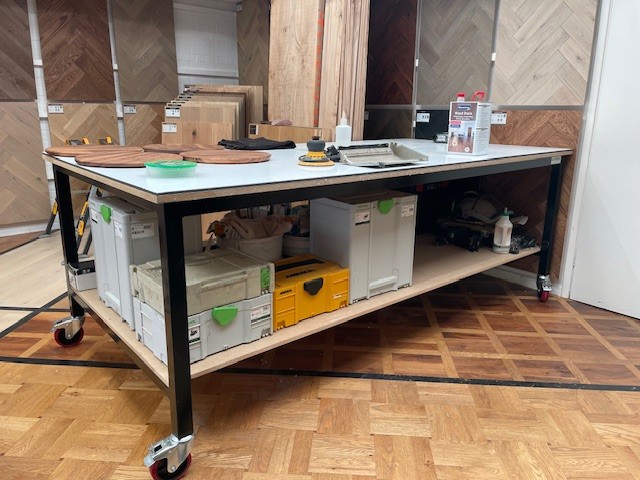
With so many options available, choosing the best industrial workbench requires careful consideration of factors such as material durability, weight capacity, storage solutions, and adaptability to specific industrial applications.
At Rhino, we understand the challenges businesses face in selecting robust and reliable workbenches that enhance workflow without compromising on safety or durability.
In this guide, we break down everything you need to know to make an informed decision, ensuring your workspace is equipped with a workbench that meets both your operational and ergonomic requirements.
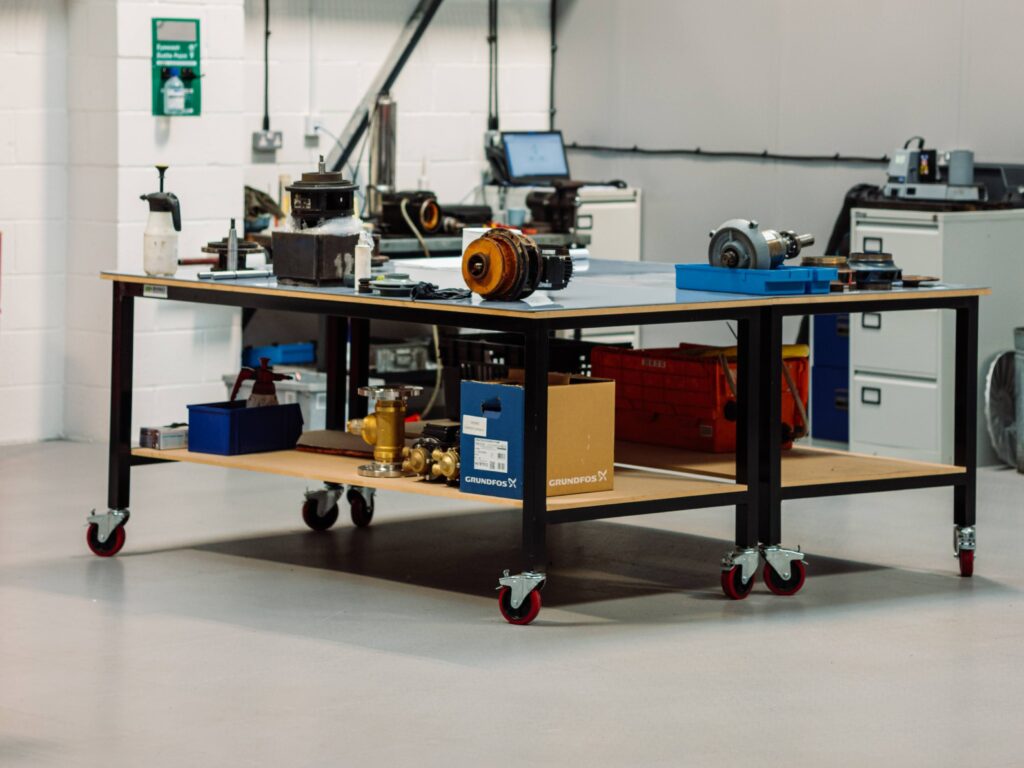
Key Takeaways
- Material Matters: The durability and performance of a heavy-duty workbench depend on its construction. Steel frames provide superior strength, while worktops made from wood, steel, or composite materials cater to different industrial applications.
- Load Capacity is Crucial: A workbench’s weight capacity must align with your operational needs to ensure stability and prevent structural failure when handling heavy tools, machinery, or materials.
- Ergonomics Enhance Productivity: Adjustable height options and ergonomic designs reduce strain on workers, improving comfort and efficiency in industrial settings.
- Storage and Accessories Improve Workflow: Built-in storage solutions such as drawers, shelves, and pegboards help keep workspaces organised, while optional add-ons like power outlets and lighting enhance functionality.
- Choosing Between Mobility and Stability: Fixed workbenches offer maximum sturdiness for heavy-duty tasks, while mobile workbenches provide flexibility for dynamic work environments.
Assessing Your Industrial Needs
Identify the Primary Tasks and Applications
Before choosing a workbench for industrial use, consider the primary tasks it will support.
- Manufacturing & Assembly: If your team frequently assembles products or works with mechanical components, a robust steel-framed workbench with a durable surface, such as a hardwood or steel top, is ideal. A workstation with built-in tool storage and power sockets will enhance efficiency.
- Electronics & Precision Work: For delicate tasks such as circuit board assembly or intricate repairs, a static-dissipative workbench with anti-static surfaces and integrated lighting is a must. Adjustable height features can also help workers maintain precision over long periods.
- Automotive & Heavy Engineering: Mechanics and engineers dealing with heavy-duty machinery need a workbench with an extremely high load capacity, oil-resistant surfaces, and integrated vices or clamps for secure workholding.
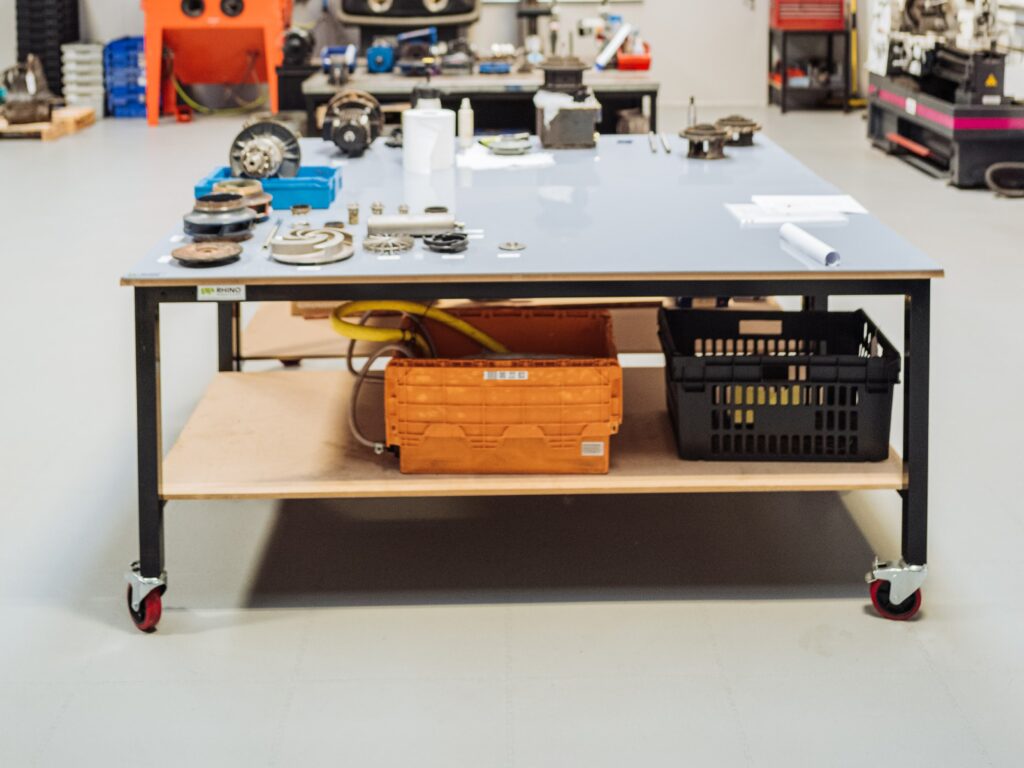
Example:
A vehicle maintenance garage requires a heavy-duty workbench that can support engine components, withstand exposure to oil and grease, and provide easy access to frequently used tools. In contrast, a laboratory environment needs a chemical-resistant surface and precision-focused features like built-in measuring guides.
Consider the Workspace Environment and Available Space
A well-planned workspace improves efficiency, safety, and comfort. Before purchasing a workbench for industrial use, consider the layout and space constraints of your facility.
- Fixed vs. Mobile Workbenches: If space is limited or your workflow requires adaptability, a mobile workbench with lockable castors might be the best option. However, for high-intensity industrial tasks, a stationary workbench secured to the floor ensures maximum stability.
- Size and Placement: Measure your available workspace to determine the right workbench size. Ensure there is sufficient room around the bench for movement, equipment placement, and team collaboration.
- Environmental Considerations: If your work area is exposed to moisture, chemicals, or extreme temperatures, selecting the right materials—such as stainless steel or powder-coated metal—will extend the lifespan of your industrial workbench.
Example:
A warehouse with ample space can accommodate large, heavy-duty workbenches with integrated shelving for bulk storage. However, a compact engineering lab may require a customisable workbench with a modular design to maximise space efficiency.
Material Selection
Frame Construction: Strength for Heavy-Duty Applications
The frame is the backbone of any industrial workbench, determining its stability and weight-bearing capacity.
- Steel Frames: Steel is the most reliable choice for heavy-duty industrial workbenches, offering exceptional strength and resistance to wear and tear. Powder-coated or galvanised steel frames provide added protection against corrosion, making them ideal for workshops, manufacturing plants, and automotive garages.
- Aluminium Frames: While lighter than steel, aluminium frames are still strong and corrosion-resistant. They are commonly used in environments where mobility and weight reduction are priorities, such as electronics assembly or laboratory work.
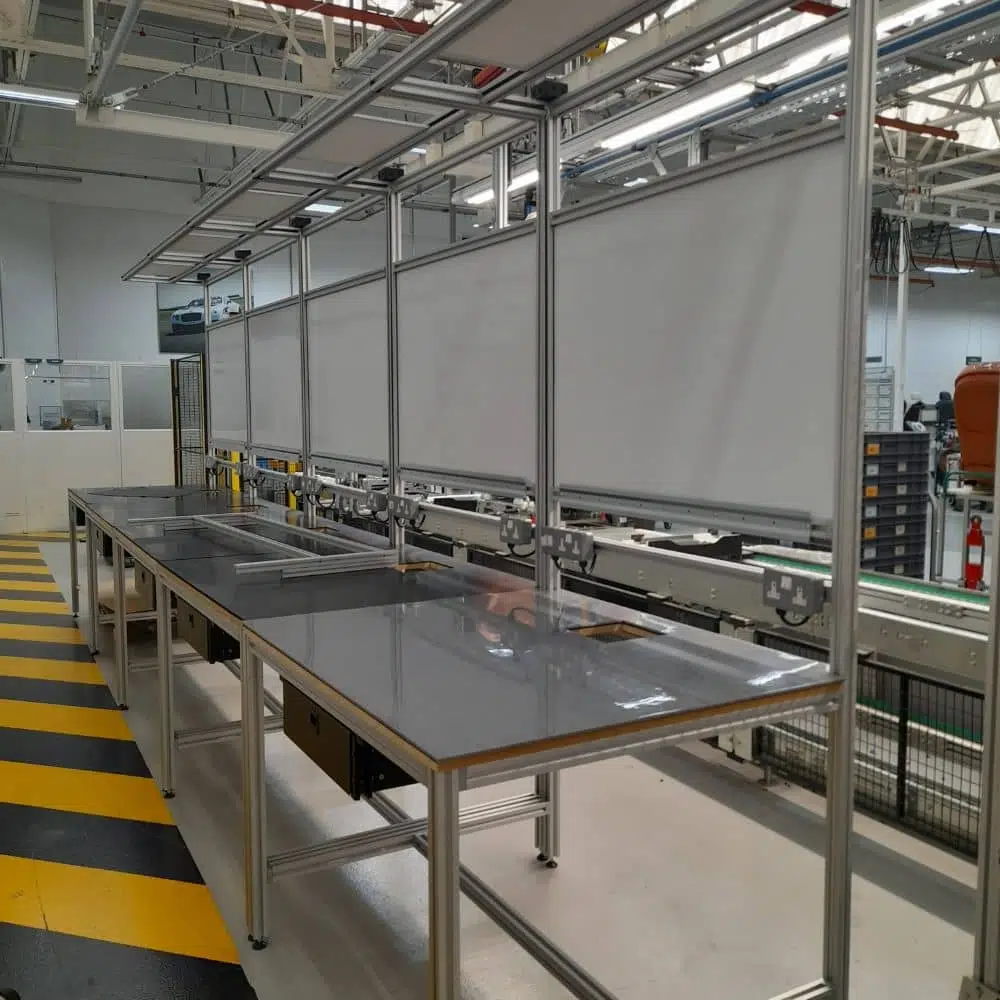
Example:
A steel-framed workbench is essential in an automotive workshop where heavy parts and machinery are frequently placed on the surface. A lightweight aluminium frame, on the other hand, would be more suitable in a cleanroom or precision engineering environment where mobility is required.
Work Surface Options: Choosing the Right Material for the Job
Wood Worktops:
- Ideal for applications requiring shock absorption, such as hammering, assembly work, or woodworking.
- Hardwoods like beech and maple are durable, reducing impact damage and minimising noise.
- Suitable for general industrial use but may require sealing to prevent damage from oils and chemicals.
- Example: A wooden worktop is perfect for a carpentry workshop where frequent use of hand tools like chisels and hammers requires a surface that absorbs impact without damaging delicate tool edges.
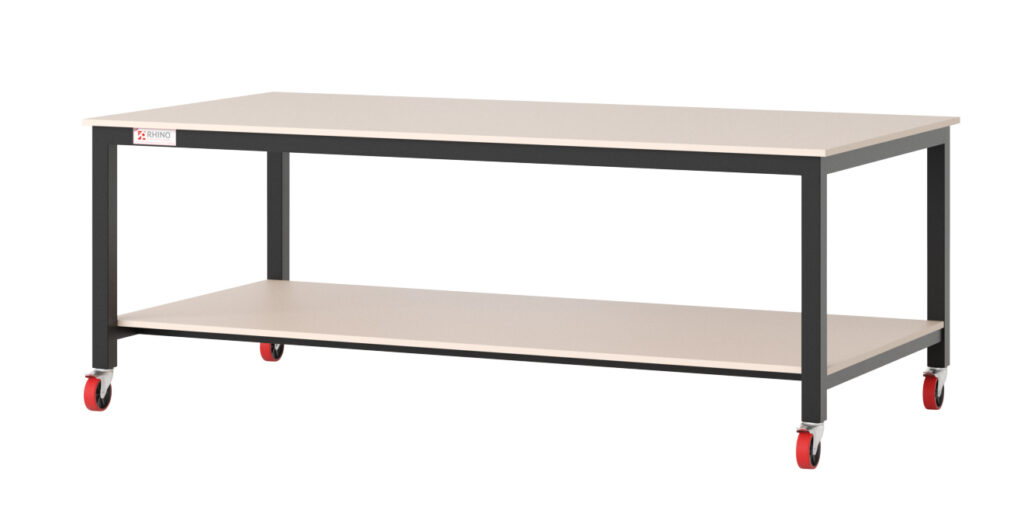
Steel Worktops:
- Highly resistant to chemicals, oils, and solvents, making them ideal for machine shops and automotive industries.
- Easy to clean and maintain, preventing contamination in industrial environments.
- Can handle extreme weight and high-pressure work without denting or warping.
- Example: A stainless-steel workbench in a metal fabrication workshop provides a robust, easy-to-clean surface that withstands exposure to oils, lubricants, and welding sparks without degrading.

Composite & Laminate Worktops:
- Resistant to moisture, chemicals, and heat, making them suitable for laboratories, food processing, and pharmaceutical environments.
- Non-porous surfaces prevent contamination, ensuring compliance with hygiene standards.
- Often include anti-static or fire-resistant properties for specialised industrial applications.
- Example: In a chemical testing lab, a composite worktop prevents damage from chemical spills while providing a non-reactive surface for experiments and sample handling.
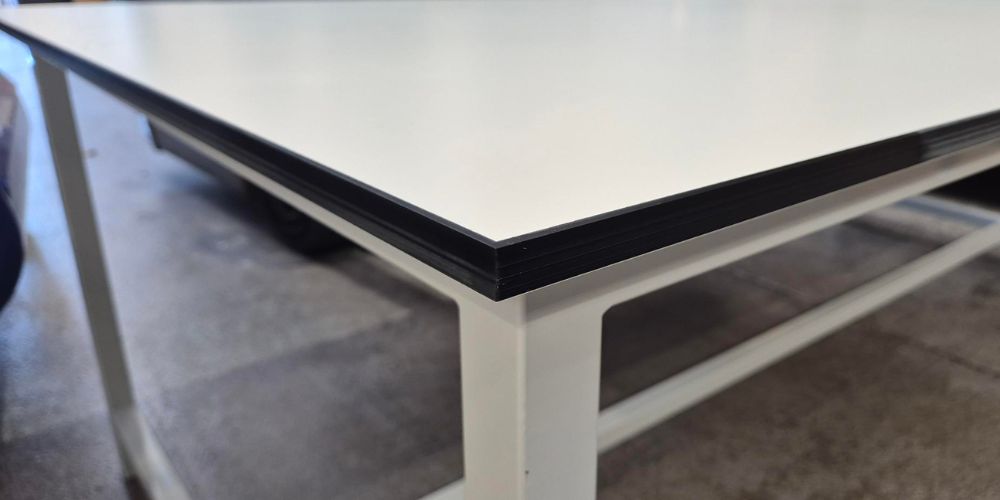
Load Capacity Considerations
Evaluating the Maximum Weight the Workbench Needs to Support
Different industries require workbenches with varying levels of load capacity. Before making a decision, consider the heaviest items, tools, and materials that will be placed on the workbench.
- Light-Duty Work (Up to 250kg): Suitable for tasks such as packaging, electronics assembly, or small component repairs where minimal weight is applied.
- Medium-Duty Work (250kg – 750kg): Ideal for general industrial applications such as mechanical assembly, light engineering, and tool maintenance.
- Heavy-Duty Work (750kg – 2000kg+): Designed for environments where large machinery, engine components, or metal fabrication work is carried out.
Example:
A laboratory workbench used for assembling small electronic devices may only need a 250kg capacity, whereas an automotive repair workbench handling vehicle parts and heavy tools must support at least 1000kg to ensure safety and stability.
Ensuring the Workbench’s Load Capacity Matches Your Requirements
- Check Manufacturer Ratings: Always refer to the manufacturer’s stated load capacity, which should account for evenly distributed weight. If placing concentrated loads (e.g., heavy machinery), ensure the bench is reinforced.
- Consider Static vs. Dynamic Loads: If the workbench will be subject to movement, vibration, or impact (e.g., from heavy tools or machinery operations), select a model with additional weight tolerance.
- Frame Strength and Surface Durability: A reinforced steel frame and thick, high-quality work surface help prevent bending or warping over time, ensuring long-term reliability.
Example:
A steel fabrication shop requires a high-load capacity workbench capable of supporting over 1500kg due to the weight of metal components, welding tools, and power equipment. Choosing a reinforced steel-frame workbench with a solid steel worktop ensures stability under high-stress conditions.
Ergonomics and Adjustability
Opt for Workbenches with Adjustable Height Features
A fixed-height industrial workbench may suit some tasks, but in environments where multiple workers share the same workstation or where tasks require different working heights, an adjustable-height workbench is the best solution.
- Improved Comfort & Productivity: Adjustable workbenches reduce strain on the back, shoulders, and neck, helping to prevent work-related injuries.
- Accommodates Different Work Requirements: Sitting and standing work options allow workers to shift positions, improving circulation and reducing fatigue over long shifts.
- Compliance with Workplace Safety Standards: Many industries are adopting ergonomic regulations to improve workplace safety—adjustable workbenches help businesses meet these standards.
Example:
A precision engineering firm requires workers to perform delicate assembly tasks for long hours. An adjustable-height workbench allows each worker to set the optimal height, reducing strain and increasing focus and accuracy.
Consider Lift Mechanisms for Ease of Use
- Manual Hand Crank Adjustments: Ideal for light to medium-duty applications where occasional height adjustments are required. Cost-effective and reliable but may not be suitable for heavy loads.
- Electric Height Adjustments: Best for workstations with frequent height changes or where heavier loads are involved. Provides effortless, precise adjustments at the push of a button, enhancing worker efficiency.
- Hydraulic or Pneumatic Lift Systems: Suitable for heavy-duty industrial workbenches, allowing easy height changes even under significant loads.
Example:
In a vehicle assembly plant, technicians work with both small electrical components and large mechanical parts. An electric height-adjustable workbench enables seamless transitions between tasks, ensuring an ergonomic and efficient workflow.
Storage Solutions and Accessories
Incorporate Drawers, Shelves, and Pegboards for Efficient Organisation
An industrial workbench isn’t just a flat surface—it can be customised to include built-in storage that keeps essential tools within easy reach and minimises clutter.
- Drawers: Ideal for storing hand tools, fasteners, and small components, reducing the risk of misplacement. Lockable drawers provide added security for valuable tools.
- Shelves: Under-bench or overhead shelving can store bulkier items, such as power tools, spare parts, or materials, freeing up workspace while keeping essential supplies accessible.
- Pegboards & Tool Racks: Mounted pegboards allow workers to hang frequently used tools, making it easy to grab what’s needed without rummaging through drawers. Labelling pegboard sections further enhances organisation.
Example:
A precision engineering workshop benefits from a workbench with drawers and a pegboard, ensuring that delicate measuring tools, spanners, and small components are stored safely and can be accessed without disrupting workflow.
Customise with Additional Accessories to Enhance Functionality
The best industrial workbenches are adaptable, allowing businesses to add custom accessories that improve efficiency and safety based on specific work requirements.
- Integrated Lighting: Task lighting or overhead LED lamps reduce eye strain and improve visibility, especially in precision-focused industries such as electronics or jewellery manufacturing.
- Power Outlets & USB Ports: Built-in power access allows workers to plug in tools, testing equipment, or computers without relying on extension leads, improving convenience and workplace safety.
- Vices & Clamps: Essential for mechanics, metalworkers, and carpenters, securely fastening materials for cutting, drilling, or assembly work.
- ESD (Electrostatic Discharge) Protection: For electronics assembly, anti-static mats and ESD wrist strap connections help prevent damage to sensitive components.
Example:
An automotive repair workshop benefits from a workbench with integrated power outlets, allowing mechanics to operate electric tools such as drills and polishers directly at their workstation. Adding a mounted vice ensures stability when working on vehicle parts.
Mobility vs. Stability
Stationary Workbenches: Maximum Stability for Heavy-Duty Tasks
A fixed industrial workbench is the preferred choice for environments where stability and durability are top priorities. These benches are designed to handle high loads, heavy machinery, and precision tasks, making them essential for industries that rely on a rock-solid workstation.
Benefits of Stationary Workbenches:
- Exceptional Load-Bearing Capacity: Capable of supporting heavy tools, equipment, and machinery without risk of movement or structural failure.
- Long-Term Durability: Designed for intensive use, often featuring reinforced steel frames and thicker worktops to withstand impact, vibrations, and pressure.
- Enhanced Safety: Securely positioned to prevent accidental movement, reducing the risk of injuries, spills, or damage to expensive tools and components.
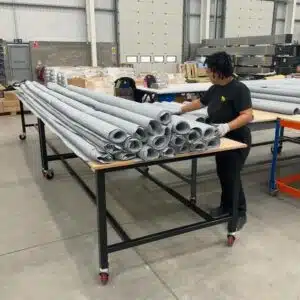
Example:
A metal fabrication workshop requires a fixed steel workbench to support the weight of large metal sheets and withstand the pressure from welding, grinding, and cutting processes. Stability is crucial to ensure accuracy and worker safety.
Mobile Workbenches: Flexibility for Dynamic Workspaces
For workplaces that require reconfigurable workstations, a mobile workbench is the ideal solution. Designed with heavy-duty castor wheels, these workbenches can be moved and locked into place as needed, making them highly adaptable for industries with shifting workstations or multi-functional tasks.
Benefits of Mobile Workbenches:
- Flexibility & Adaptability: Easily moved across workspaces, allowing workers to reposition the bench based on different tasks or workflow needs.
- Improved Space Management: Ideal for smaller workshops or multipurpose areas, where workstations need to be adjusted for efficiency.
- Lockable Castors for Stability: High-quality industrial casters with locking mechanisms ensure that the workbench stays in place when in use.
Example:
A vehicle maintenance garage benefits from a mobile heavy-duty workbench, allowing mechanics to move the workstation closer to different vehicles. When stability is needed, the wheels can be locked, ensuring a secure, sturdy surface for tool storage and repair work.
Safety and Compliance
Ensure the Workbench Meets Industry Safety Standards and Regulations
- Weight Capacity Standards: Ensure the workbench is rated to safely handle its advertised load capacity, preventing collapse or structural failure.
- HSE & Workplace Safety Regulations: In the UK, workplace furniture must adhere to Health and Safety Executive (HSE) guidelines to protect workers from ergonomic injuries and hazards.
- Fire and Chemical Safety Compliance: In sectors such as laboratories, manufacturing, or chemical processing, workbenches must be made from fire-resistant and chemical-proof materials to comply with industry standards.
Example:
A workbench used in a laboratory must meet chemical resistance and fire safety regulations, ensuring that spills or exposure to hazardous substances do not compromise worker safety or damage the work surface.
Look for Features that Enhance Safety
- Rounded Edges & Corners: Prevents accidental injuries caused by sharp or exposed metal edges, especially in high-traffic areas.
- Non-Slip Surfaces: Reduces the risk of tools slipping or workers losing grip, particularly in environments with oil, grease, or other fluids.
- Fire-Resistant Materials: Essential for welding, metalworking, or laboratories, where workbenches may be exposed to sparks, heat, or flammable materials.
- Anti-Static (ESD) Protection: Prevents electrostatic discharge in electronics assembly or areas where static-sensitive components are handled.
Example:
A workshop dealing with metal grinding and welding should use a steel-topped workbench with fire-resistant coatings to reduce the risk of sparks igniting flammable materials. Meanwhile, an electronics repair bench needs an ESD-safe surface to protect delicate circuitry.
Budget Considerations
Balancing Cost with Features and Durability
When setting a budget for an industrial workbench, consider which features are essential for your operations and which may be unnecessary add-ons.
- Frame Strength and Build Quality: A reinforced steel frame may cost more upfront but will outlast a lower-quality alternative, reducing the need for early replacements.
- Work Surface Material: Worktops made from hardwood, steel, or composite materials may have a higher initial price but provide superior resistance to wear, chemicals, and impact, ensuring long-term use.
- Load Capacity and Customisation: Higher weight-bearing capacities and built-in accessories like drawers and power outlets may increase costs but significantly improve efficiency and workspace organisation.
Example:
A metal fabrication business that frequently handles heavy components and welding tasks should invest in a high-load capacity steel workbench, even if it costs more than a basic model. A cheaper alternative may warp under pressure or require costly modifications later.
Considering Long-Term Value and Maintenance Costs
Rather than focusing solely on the upfront purchase price, businesses should assess the total cost of ownership over the workbench’s lifespan.
- Durability Reduces Replacement Costs: A high-quality workbench will last years or even decades, whereas a low-cost alternative may require frequent repairs or early replacement.
- Minimal Maintenance Saves Money: Certain materials, like powder-coated steel frames and chemical-resistant surfaces, require less maintenance and withstand harsh conditions better than untreated materials.
- Modular and Expandable Workbenches: Investing in a customisable or modular workbench allows for future expansion, preventing the need for a full replacement as business operations grow.
Example:
A workshop investing in a modular workbench system can gradually add new storage components, lighting, or power outlets as needed, instead of replacing the entire workstation when requirements change.
To Wrap Up
By evaluating key factors such as frame strength, work surface materials, load capacity, ergonomics, storage solutions, mobility, and compliance with safety regulations, businesses can invest in a workbench that truly supports their operational needs. Whether you require a fixed, high-load capacity workstation for heavy-duty engineering or a mobile, adaptable bench for a dynamic workshop, making an informed decision will result in a safer, more efficient workspace.
At Rhino, we understand the importance of selecting the best industrial workbench tailored to your business requirements. With the right choice, you can create a well-organised, high-performance industrial environment that enhances both worker efficiency and long-term operational success.
